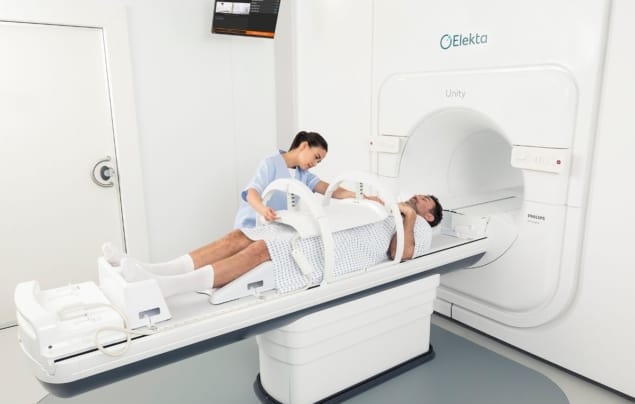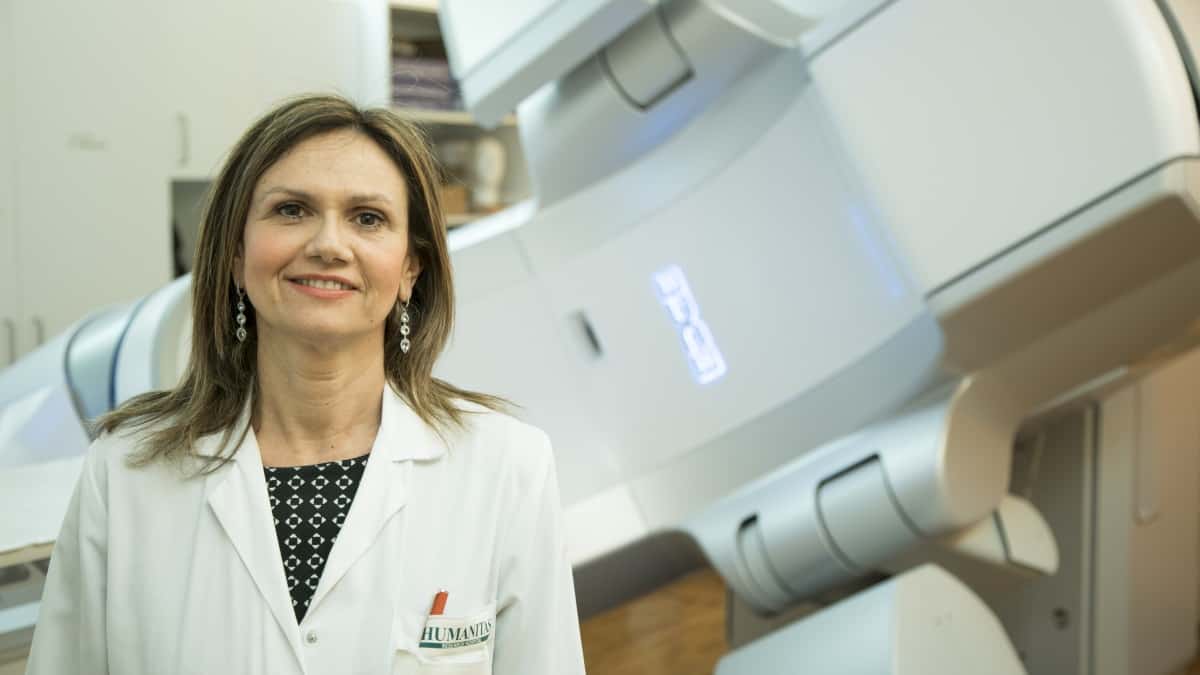
The clinical introduction of MR-guided radiation therapy has brought high-contrast soft-tissue imaging into the radiotherapy workflow. MRI can visualize tumour targets and surrounding organs with high accuracy, delivering the ability to “see what you treat” and, ultimately, the potential for real-time treatment adaptation based on anatomical changes observed during treatment.
But how prevalent is the need for online adaptive radiotherapy (ART)? And is the MR-linac a necessity to achieve this – or could other technologies fulfil future requirements just as well? These questions were examined at the recent ESTRO 2020 congress, where four experts debated the motion that “there is no future for ART in external-beam radiotherapy without an MR-linac”.
Optimizing advances
The first speaker, Uwe Oelfke from the Institute of Cancer Research/The Royal Marsden, argued for the motion, albeit with a more modest take: “We believe that there will be significantly less improvement for radiotherapy patients without an MR-linac,” he stated.

Looking at future requirements for radiotherapy, Oelfke suggested that these will include safe hypofractionation, development of response/physiology-guided radiotherapy and, further ahead, increased application of radiotherapy for treating advanced, non-localized disease.
“For this, we urgently need new technologies,” said Oelfke. “We need ultra-hypofractionation guided by real-time ART, we need to exploit imaging signals that have a different quality of information, such as biological imaging, and we need more patient-friendly treatment schedules. Step one is the introduction of technology like the MR-linac.”
Oelfke argued that the MR-linac is key to enabling safe, anatomically-driven ultra-hypofractioned treatments, delivered in one to three fractions. By reducing the number of required hospital visits, this approach will improve both patient comfort and treatment efficiency, as well as offering overall economic benefits.
The MR-linac also removes the need for implanted fiducials, enabling surrogate-free anatomy monitoring in a few hundred milliseconds. High-quality MR images acquired at the time of treatment improve both treatment safety and quality, and simply cannot be achieved by X-ray guidance, emphasized Oelfke. Meanwhile, online dose reconstruction will provide “the ultimate treatment QA while the patient is treated,” he added.
Oelfke next considered the development of biologically-driven radiotherapy. When a radiation treatment is unsuccessful, is this failure due to missing the target, he asked, or could it be due to incorrect correlation of the dose with the underlying tissue biology? “By definition, X-ray imaging is biology blind,” he said. “Functional MRI, however, is closer to biology and can monitor physiology. Hypoxia imaging, diffusion imaging and fingerprinting are tremendous opportunities. The MR-linac is needed so that we can see these signals at the time of treatment.”
Further into the future, radiotherapy may move from being a symptom-driven technique that treats localized tumours to a mechanism-driven therapy that can tackle disseminated disease. “Currently, there is no real bridge between local radiotherapy and immunotherapy, biologically-targeted therapy and chemotherapy. The MR-linac can be part of this bridging technology,” said Oelfke.
Sensible selection
“I believe there is a future for ART without MR-linac,” declared the second speaker, Marta Scorsetti from Humanitas University.

Scorsetti explained that while the need for ART is increasing, it is not yet part of routine clinical practice, likely due to the challenge of performing the full planning workflow while the patient is on the couch. The MR-linac could indeed address this unmet need for daily plan adaptation and possibly also enable tumour tracking during treatment. “This should be a dream for radiation oncologists,” said Scorsetti. “But in my mind, there are some points that deserve clarification.”
One major obstacle is time. Scorsetti noted that in a centre-of-excellence in Italy using an MR-linac, the mean treatment time is 50 minutes, limiting the number of patients that can be treated each day. This contrasts with other recent radiotherapy advances that reduce beam-on times, enabling more treatments per day and lowering intrafraction motion.
By 2025, the number of radiotherapy courses needed in Europe is expected increase by 16%. And even now, not all patients that need it can get radiotherapy. “So would online adaptation really benefit patients or further reduce the ability to treat all of them?” Scorsetti asked. “We can’t treat all patients we would like to with an MR-linac, or we will not be able to treat all patients who need radiotherapy. Patient selection criteria are urgently needed.”
Scorsetti also pointed out that the MR-linac is not the only technology available for daily adaptation. For example, the new ETHOS radiotherapy system offers online ART based on cone-beam CT (CBCT). “Using ETHOS, the treatment time should be five to 10 minutes, compared with 30 to 50 minutes for the MR-linac,” she said.
But rather than focusing on which technology to use, what’s more important is defining which patients would benefit most from online adaptation and using this opportunity to make real clinical improvements. Scorsetti concluded by quoting Henry Ford: “Real progress happens only when advantages of a new technology become available to everybody,” she said.
Biological benefits
“We have been working with the 1.5T MR-linac for more than two years now,” stated Cihan Gani, a radiation oncologist at University Hospital Tübingen.

The main advantage, Gani said, is the ability to record an MR image for every fraction and use these to create plans optimized to the anatomy of the day. The most intuitive application is adapting treatment plans for tumour shrinkage. Gani shared an example of a head-and-neck tumour that shrank with each week of treatment. He noted that while CBCT can visualize air–tumour interfaces (although these are clearer on MRI), within soft tissues, it is far harder to see tumour borders using CBCT. Here, MR imaging is the only option for tracking tumour volume.
The adaptation workflow is also far simpler with an MR-linac. Images are recorded immediately before treatment and the plan adapted accordingly, using one device. Without an MR-linac, images must be recorded on a separate scanner, at imaging times reserved in advance. Critically, as it’s not known exactly when a tumour will shrink, such pre-defined imaging sessions may miss important changes.
Another reason to employ an adaptive workflow is for treatments near organs-at-risk (OARs) with high anatomic variability. In pancreatic cancer, for example, it is beneficial to be able to adapt the treatment plan based on the current position of the small bowel, which is hard or impossible to see using CBCT.
And MRI has another advantage: functional imaging, which provides information on tumour biology and could enable biological plan adaptation. Gani described an example in which a rectal cancer patient treated on an MR-linac had diffusion-weighted imaging MR scans twice weekly. While the tumour did not shrink over the course of treatment, suggesting that it had not responded, the apparent diffusion coefficient (ADC) values increased with time, indicating tumour response. ADC maps could potentially also be used to identify areas of residual tumour to boost the dose to such regions.
“With the MR-linac, you have the possibility to adapt without relying on anatomy that was there weeks ago. Plus you have many more possibilities for novel treatments if you also include biological information,” Gani concluded. “So yes, there is a future for ART without an MR-linac, but the options are limited. It clearly depends on how the future shall look like, and it looks best if you do ART with an MR-linac.”
Cost considerations
Rounding off the debate, Stine Korreman from Aarhus University Hospital suggested that the motion under consideration was actually a little biased. “Of course MR-linacs will be part of ART in future,” she said. “Maybe the more relevant questions are whether all linacs will eventually be replaced by MR-linacs. Or will all images for ART eventually be MR images? Or will all major ART research be directed towards MR-linacs?”

These questions address different considerations: cost effectiveness, benefit and innovation potential, respectively. Looking first at cost, Korreman noted that the MR-linac is at least four times more expensive than a CBCT-equipped linac – and cannot treat as many patients per hour. “What is gained with one MR-linac compared with the four CBCT-linacs you could get for the same price?” she asked.
Korreman next examined potential improvements in outcome, noting that the main objectives of ART are to monitor treatment response and reduce margins. Response monitoring enables adaptation of either the spatial dose distribution or the fractionation regime. “But for both these, the role of MR is not entirely clear; both are at an early stage with little clinical evidence, though there is interesting potential,” she said.
Previous studies have demonstrated that ART can reduce margins by up to 5 mm. “But removing 5 mm of high-dose volume corresponds to just 5% reduction of the integral dose to the patient,” Korreman said. Even looking at the extreme of margin reduction, such that radiotherapy approaches surgery, treatments are still limited by knowledge of what to cut out or where to aim. “Geometric margin reduction has limited potential and response monitoring seems to be premature. So the benefits don’t seem to make up for the large cost,” she said.
Looking at the potential of imaging-related developments in radiotherapy, there are many other important imaging objectives unrelated to ART – such as target and OAR identification, biological target differentiation or proton range verification. Further ahead, the introduction of techniques such as FLASH radiotherapy, grid therapy and immuno-radiotherapy may lead to completely different image guidance and adaptation needs.
“Given that cost will not be reduced enough to be competitive, there will not be enough clear benefits to balance this cost, and innovation will continue to happen at a more rapid pace for other modalities for some time to come,” said Korreman. “The conclusion must be that, in the foreseeable future, MR-linacs will not replace other modalities for adaptive radiotherapy.”
With the ESTRO congress a totally online event this year, the traditional show-of-hands vote at the end of the debate did not take place. I will leave it to the readers to make up their own minds as to how the future of ART will pan out.



